SUMMARY
This is AI generated summarization, which may have errors. For context, always refer to the full article.
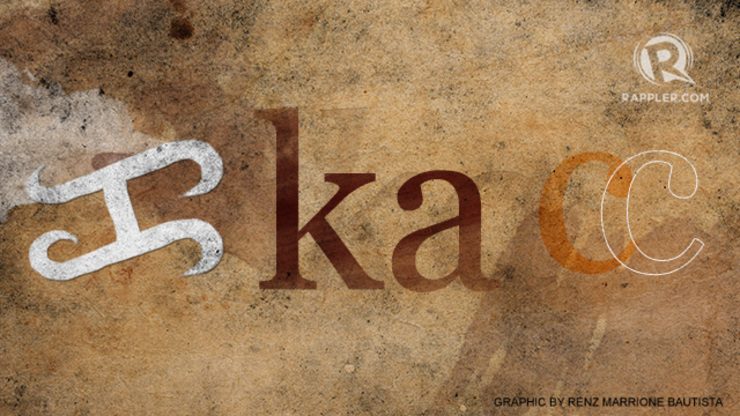
MANILA, Philippines – Like many nations colonized by westerners, the Philippines eventually adopted the Latin alphabet for its national language, Filipino.
Currently, the Filipino alphabet has 28 letters:
A, B, C, D, E, F, G, H, I, J, K, L, M, N, Ñ, NG O, P ,Q, R, S, T, U, V, W, X, Y, and Z
Before today, the number of letters in the Filipino alphabet varied, given that we first had the pre-Hispanic baybayin, then 400 years of using the Latin alphabet, and with many regional languages influencing the way Filipinos write.
On National Language Month, Rappler traces the development of the Filipino alphabet.
Pre-colonial to early colonial period: Baybayin
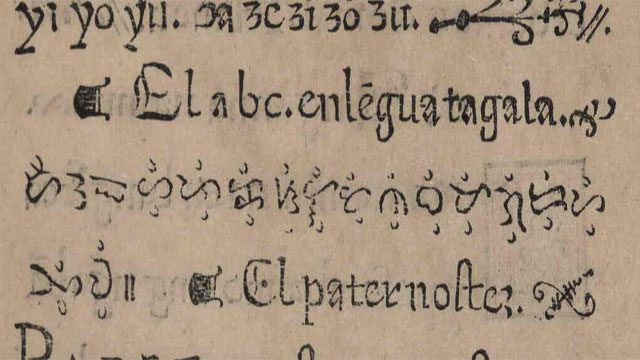
Early in the pre-colonial period, the ancient peoples of the Philippines did not have any writing system, and so they relied on oral tradition in recording folklore and folk history.
Sometime in the 13th century, writing systems derived from the Indian-influenced cultures of Indonesia and Malaysia came to the islands, leading to the emergence of native writing systems called baybayin, primarily used by certain inhabitants of Luzon and the Visayas.
Baybayin is an alpha-syllabic script, meaning certain characters in baybayin can stand for either a single consonant or vowel, while some characters stand for an entire syllable.
According to Antonio de Morga’s Events in the Philippine Islands (1609), and the Doctrina Christiana, a catechism and one of the first books ever printed in the Philippines (1593), baybayin had 3 alphabet characters representing vowels (A, E/I, and O/U), while there were 14 characters representing syllables that begin with the consonants (B, C/K, D/R, G, H, L, M, N, NG, P, S, T, W, and Y).
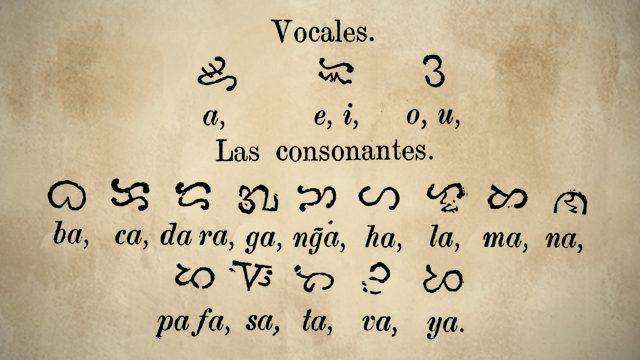
In the Tagalog version of baybayin, syllabic characters in themselves consist of a consonant followed by the vowel A (i.e. ba, ca, da/ra). In order to change the vowel of the syllable, a mark – called a kudlit – is added. Adding a kudlit above syllabic character changes the vowel sound from A to E/I.”
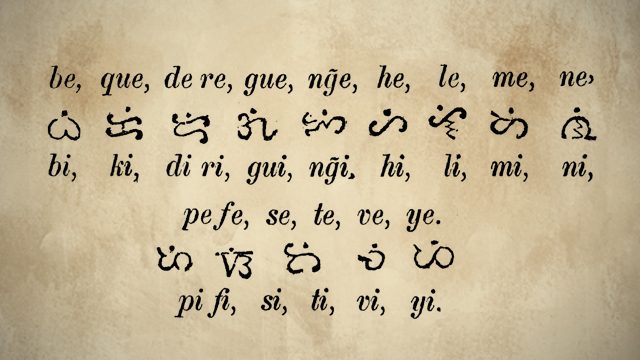
Placing a kudlit below a syllabic character modifies the vowel to an O/U sound.
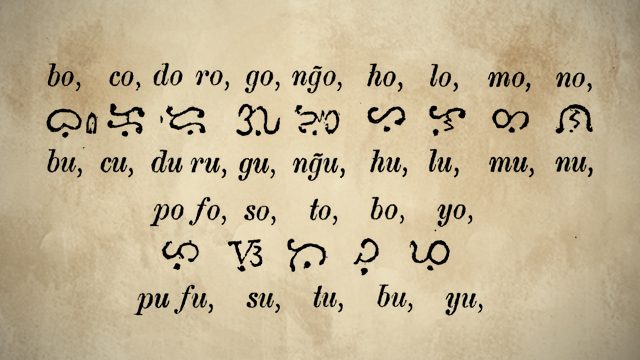
The extent to which early Filipinos were literate in the native script varied from region to region over the span of the 16th to early 17th centuries.
During Magellan’s arrival in the Visayas in 1521, his chronicler, Antonio Pigafetta, noted that the Visayans were illiterate. The natives were amazed when he wrote down some of their words and repeated it to them. On the other hand, in the 1600’s, Morga stated that the natives of Luzon and its surrounding Islands wrote excellently in the native script and that there were only very few who did not write it well.
Contrary to Morga’s statement, however, American historian William Henry Scott found records in which even lordly Datus (chieftains), when asked to sign land titles, did not know how to write.
Spanish period: Abecedario
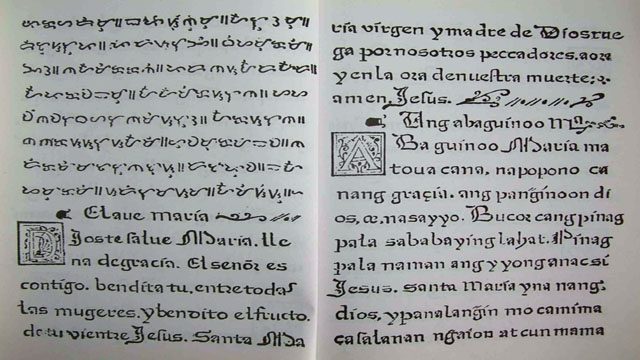
With colonization under Spain came the Latin alphabet and the decline and eventual disuse of baybayin. Spanish missionaries, who served as the first teachers in the islands, taught converted Filipinos Catholicism, the Latin alphabet, and the Spanish language.
An evidence of this was the Doctrina Christiana, which was published in Tagalog and Spanish. The book outlines the basic beliefs of Christianity and Christian prayers in the Spanish using the Latin alphabet first, then translated into Tagalog in both baybayin and in the Latin alphabet.
The Doctrina does not begin with prayers but with a short instruction in the Latin alphabet, a syllabary, and its counterparts in the Tagalog baybayin script. The alphabet, as it appears in the Doctrina, consist of the following:
A, B, C, D, E, F, G, H, IJ, L, M, N, O, P, Q, RR, S, T, U, V, X, Y, and Z
RR appeared in Spanish words like barricada (barricade).
Beginning in the 17th Century, colonized Filipinos followed the Spanish alphabet and its developments. Eventually, the number of letters in the alphabet used In the islands, called the abecedario, reached 32 letters:
| Letter | A | B | C | CH | D | E | F | G |
| (Spanish) Pronunciation | Ah | Be | Se | Che/Se-hache | De | Eh | Efe | Ge/He |
| Letter | H | I | J | K | L | LL | M | N |
| Pronunciation | Hache | Ih | Jota | Ka | Ele | Elye | Eme | Ene |
| Letter | Ñ | ÑG | O | P | Q | R | RR | S |
| Pronunciation | Enye | Enye-ge | Oh | Pe | Cu | Ere | Er-re | Ese |
| Letter | T | U | V | W | X | Y | Z | |
| Pronunciation | Te | Uh | Ve/Uve | Uve-Doble/Wa | ekis | I griega/Ye | Zeta |
“LL” stood for an “elye” sound for Spanish words, like caballo (horse) or relleno (stuffed), while ÑG represented an “enye-ge” sound, found in names like Zuñga.
Today, the abecedario letters CH, LL, and RR are still used in the alphabet of the Chavacano language, a heavily Spanish-based creole (mixed Spanish/Native) language commonly spoken in Zamboanga City in Mindanao and some parts of Cavite City in Luzon.
American to the Commonwealth eras: Abakada
The end of Spanish rule and the arrival of the American style public education in the Philippines introduced Filipinos to the English language and to its 26-letter alphabet. Despite this, the abecedario remained in use by Philippine languages, as many words still used Spanish letters.
However, the use of abecedario was threatened by both the English-based educational and Philippine nationalism. In 1937, following the establishment of the Philippine Commonwealth, the government ordered for the adoption of a national language based on Tagalog, and for the preparation of a dictionary and a grammar book for the national language.
In 1939, Lope K. Santos developed Ang Balarila ng Wikang Pambansa (The Grammar of the National Language). Apart from rules on grammar, it contained the alphabet for the national language – the abakada, named after its first 3 letters. Following the advice of past scholars, Santos retained only one letter to represent a significant sound in the Tagalog language –for example, since C, Q, and K often made the same sound in Tagalog, only one should be retained.
The resulting product of this logic reduced the 32 letter abecedario into 20 letters. Furthermore, the letters were to be read in an abakada manner as opposed to the English or Spanish pronunciaton of the letters.
| Letter | A | B | K | D | E | G | H | I | L | M |
| Abakada Pronunciation | Ah | Ba | Ka | Da | Eh | Ga | Ha | Ih | La | Ma |
| Letter | N | NG | O | P | R | S | T | U | W | Y |
| Abakada Pronunciation | Na | Nga | Oh | Pa | Ra | Sa | Ta | Uh | Wa | Ya |
1970’s: Revised abakada
Abakada remained the national language’s alphabet from 1940 to 1976. In that period, questions were raised about the validity of Tagalog as basis of the national language, as majority of Filipinos spoke other native Philippine languages, causing a debate in the definition of the national language.
The 1973 Constitution issued a new definition of the national language, renaming it as Filipino and stating that it is a language in the process of development. Based on this definition, a revision of the Filipino alphabet was needed, as abakada was a Tagalog alphabet.
This change in the alphabet followed the 1976 Filipino Orthography Reform approved by the Institute of the National Language. Under Department of Education, Culture and Sports (DECS) memorandum order 194, 11 letters made a comeback in the revised Filipino alphabet – C, CH, F, J, LL, Ñ, Q, RR, V, X, and Z – reflecting the other Filipino languages that still used those letters.
With the 11 letters included, the1976 alphabet became similar to the old abecedario with its 31 letters:
A, B, C, CH, D, E, F, G, H, I, J, K, L, LL, M, N, NG, Ñ, O, P ,Q, R, RR, S, T, U, V, W, X, Y, and Z
However, the revised Filipino alphabet drew criticism due to the addition of more unnecessary letters.
1987: Present Filipino alphabet
The current 28 letter Filipino alphabet was established following the signing of the 1987 Constitution.
The new Constitution redefined the Philippine’s national language and ordered for a commission to be established to conduct researches for its development, propagation, and preservation of Filipino and other native local language. This led to creation of the Komisyon ng Wikang Filipino(Commission of the Filipino Language).
Following the constitutional mandate of developing Filipino with the other non-Tagalog native languages in mind, the comission undertook a study on reforming yet again the Filipino alphabet and spelling rules of Filipino to reflect the alphabets and spelling methods of other Philippine languages.
In addition, the study factored in the Filipino-English Bilingual Education Policy in the Philippines.
The revisions were published in DECS Order No. 81 s, 1987, also known as “Alphabet and Spelling Guide of the Philippine Language.”
In the DECS Order, the new alphabet retained the 20 letters of the abakada; retained the letters C, F, J, Ñ , Q, V, X, Z on account that these letters are commonly used in many regional languages; and removed the letters CH, LL, and RR. Furthermore, the letters are to be read in English as opposed to abakada pronunciation, in accordance with the Bilingual Education policy. – Rappler.com
Sources: Blair and Robertson: The Philippine Islands, 1493-1898, Volume XXXXIII, 1519-1522, Doctrina Christiana, Calderon: Dating Pilipinas, Antonio De Morga: Sucesos De Los Islas Filipinas, Bright, William: A Matter of Typology, Alphasyllabaries and Abugidas, Barrios: Austronesian Elements in Philippine Creole Spanish, National Commission for Culture and Arts: Balanghay: The Filipino Language, NCCA: Orthography (Evolution), Yap: A Look @ Global Filipino Orthography, Komisyon ng Wikang Filipino: Kasaysayan, DECS Order No. 81 s, 1987, Komisyon ng Wikang Filipino: Manwal sa Masinop ng Pagsulat. Chavacano de Zamboanga, Sawyer: Inhabitants of the Philippines, Gomez: Evolution of the Native Tagalog Alphabet, Fr. De San Agustin, Compendio Del Arte De La Lengua Tagala, Filipino Cultural Heritage in the UST Archives: Baybayin Script in 17th Century Land Deeds.
Add a comment
How does this make you feel?


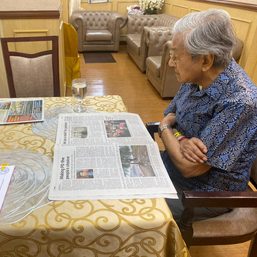

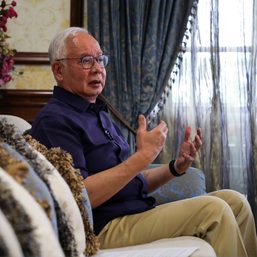
There are no comments yet. Add your comment to start the conversation.